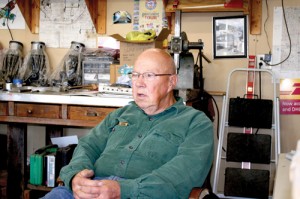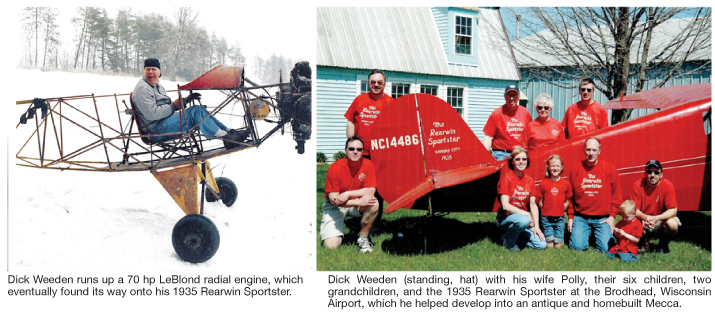by Ed Leineweber

What does it take to make a difference? Big bucks helps, for sure, but as Brodhead Airport’s Dick Weeden has demonstrated throughout his more than 60 years in aviation, what a guy might lack in money, he can more than make up for in enthusiasm, commitment, skill, knowledge and passion. Now, nearing his 80th birthday, Dick can look back with pride and satisfaction at his many aviation accomplishments. Fortunately for us, however, while he has slowed up a bit, he has not stopped contributing to the world of antique and experimental aircraft. I can personally vouch for that!
Although I’d heard Dick’s name during my occasional visits to the Brodhead Airport (C37) for the annual Midwest Antique Airplane Club’s “Grassroots” fly-in, or for the famed Pietenpol gathering the weekend before AirVenture each year, I hadn’t met him until I needed his help with my first Bowers Fly Baby back in 2009. He came through for me then and is continuing to guide me through other Fly Baby projects. As I’ve gotten to know Dick, I am reminded why I so thoroughly enjoy aviation, especially the little corner occupied by the antiquers and homebuilders. It is folks like Dick Weeden that make it so much fun.
To many, Dick is one of the early “pioneers” who, beginning in about 1970, transformed the Brodhead Airport, located about 35 miles south of Madison, Wisconsin, from an almost-dead turf field into a thriving turf field, populated by some of the most amazing antique and homebuilt aircraft assembled anywhere outside of an aircraft museum. “Brodhead” to many antique and homebuilt enthusiasts is a very special place, rivaled only by Blakesburg, Iowa, on Labor Day weekend when the Antique Airplane Association holds its annual event.
This transformation of Brodhead Airport into what it is today was in part propelled by the formation of EAA Chapter 431 in 1973. Dick was a charter member, and served as its first president. The chapter’s first meetings were in his house since there was no suitable building yet built at the airport. The Chapter 431 hangar came later, as did Dick’s own hangar and shop in 1975. Now, 40 years later, folks fly their antique and homebuilt treasures to Brodhead from all over the country, and likely will for years to come.
Others might know of Dick’s contribution via his 26-year-long effort to restore a rare 1935 Rearwin Sportster, including its equally rare 70 h.p. LeBlond radial engine. Begun in 1976 with the acquisition of a total-wreck basket case, the project came to fruition in July, 2002, when the Rearwin, which had not flown since 1958, once again took to the skies. Later that summer Dick’s restoration masterpiece won four awards at the Antique Airplane Association fly-in at Blakesburg. (The full story of the Rearwin restoration is told in Budd Davisson’s cover story in the January, 2003, edition of Vintage Airplane magazine.)
Dick is quick to point out that many other people helped him with the development of the Brodhead Airport, the EAA Chapter there, and the Rearwin project, which is certainly true. However, for fear of slighting any of these people, I won’t attempt to list here the many other contributors Dick mentioned. It is enough to acknowledge that successes like these don’t happen without lots of help from lots of people.
But group accomplishments are the synergistic results of individual efforts. Dick Weeden’s aviation efforts began in 1948 when, at age 16, he rode his bicycle eight miles to work as a line boy at the airport operated by Russell VanGalder in South Beloit, Illinois. The deal was he’d get $5.00 per week and an hour of dual instruction in a J-3 Cub. But the airplanes were so busy in those days with flight students training under the G.I. Bill that Dick only managed to get a few hours of instruction and never soloed. It would be almost 30 years later, after a stint in the Air Force and 20 years of working as a tool and die maker and raising six kids, that Dick would finally earn his pilot’s certificate.
In the Air Force Dick was trained an engine mechanic and instrument repairman. In 1968, while working full time, he earned his Airframe & Powerplant maintenance technician certificate on that same G.I. Bill. Dick began to work with local hobbyists as an A&P on their homebuilt projects, and later opened his shop on the Brodhead Airport. At one time he did 15-20 annual inspections a year working part-time after his “day job,” but has since cut way back as he attempts to slow down. “Slowing down” is a relative concept, however, as Dick’s on-going engine overhaul and restoration activities attest.
We all leave tracks behind us, whether we realize it or not. We hope that those who come upon our tracks years later will be inclined to think the better of us as they see where we have been.
A couple of years ago, while reading old copies of the Fly Baby Newsletter published in the late ‘60s for early Bowers Fly Baby builders, I came across ads Dick ran promoting his part-time business of fabricating the metal parts for the plans-built aircraft.
Of course, the prices Dick was charging seem laughable more than 40 years later ($133.63 for the complete set), but what struck me more was the reviews builders offered on the quality of Dick’s work. According to the newsletter publisher, “Everyone we talked to was much impressed by the quality and workmanship and not a single person thought the price was too high.” In a later issue, the newsletter author reports on the many letters he received praising the Weeden metal parts, some describing them as “perfect.”
“Dick obviously takes a great deal of pride in his work and it has resulted in a large number of satisfied customers,” he writes.
The legendary (to Fly Baby fanatics, anyway) Peter Bowers himself, after looking at aircraft with Weeden metal parts, is reported to have said that if he were building another Fly Baby, he would use Dick’s metal parts himself!
Pretty cool, but that’s not the best of it. The quality of Dick’s contribution to aviation is set out in his own words in that Fly Baby Newsletter ad from 40-plus years ago: “REMEMBER, THESE FITTINGS ARE GUARANTEED UNCONDITIONALLY AND IF THERE IS SOMETHING ABOUT THEM THAT YOU FEEL ISN’T SATISFACTORY, I WANT TO KNOW ABOUT IT.” (Dick’s capitalization.) When is the last time you got a guarantee like that?
Considering that many of those airplanes with Weeden metal parts are probably still flying today, that’s making a difference in my book.
Here’s hoping that each of us strive to do as well in our own lives.
